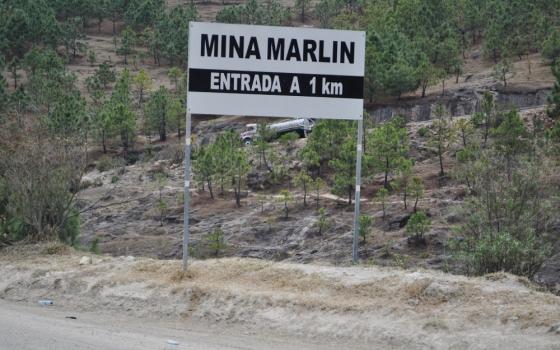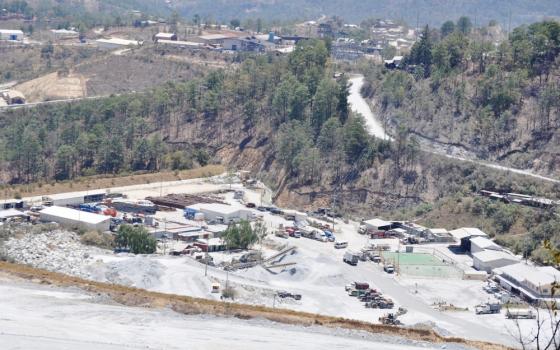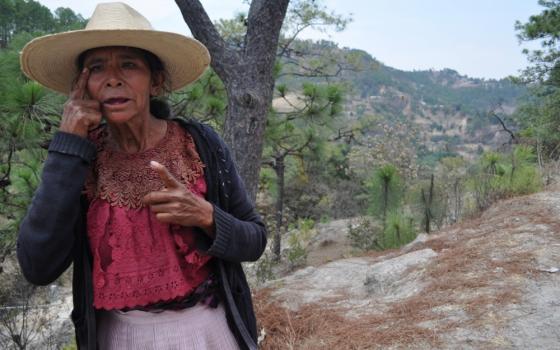Global Sisters Report presents a special series on mining and extractive industries and the women religious who work to limit the damage and impact on people and the environment, through advocacy, action and policy. Pope Francis last year called for the entire mining sector to undergo "a radical paradigm change." Sisters are on the front lines to help effect that change.
______
Sr. Maudilia Lopez remembered the truck, a silver Toyota pickup, circling the square in 2003 in San Miguel Ixtahuacán, Guatemala.
The driver said nothing about the meaning of the colors of the mountains that were home to the indigenous people here: Red, the energy of mother earth; white, the spiritual life of their ancestors; yellow, the crops that the people eat; blue for the sky and water.
Instead, the driver announced through a loudspeaker an upcoming meeting about plans for a huge project near the town. Everyone in San Miguel Ixtahuacán, Lopez recalled, had heard rumors about an international company but no one was sure what might happen. Some said it was a cement company. There used to be big rocks in the rivers. People said rocks were the right material for cement. Lopez didn't know. She was curious but not at all suspicious.
At the meeting, men in suits revealed their plans. Not for a cement factory but a gold and silver mine. Everything was set. Jobs would be offered. The local economy would prosper, stimulating economic growth. The meeting, Lopez said, was not a consultation but an announcement of their intentions. The company already had leases.
The Marlin mine, owned by Montana Exploradora de Guatemala, S.A, a subsidiary of the Canadian company Goldcorp, began operations in 2005 in the regions of San Miguel Ixtahuacán and Sipacapa, communities largely composed of indigenous Mayans who speak their native languages. The Mam, one of many Mayan nations in Guatemala, make up the majority population. They number more than 600,000 in the western regions of Guatemala.
The mine brought jobs and prosperity to some among the Mam, but by no means to all. It also changed both the landscape and the social fabric of the indigenous community.
Now, more than 10 years later, after countless protests failed to stop production, the mine will cease operations at the end of the year, renewing issues about the economics, environmental and social costs of its operation. Lopez takes little comfort in the impending closure.
"The impact of all this is money and how money has affected many families and the community as a whole is the issue," said Lopez, 44, a sister with the order of Hermanas Guadalupanas de La Salle. When she moved to San Miguel Ixtahuacán in 1996, she started religious study groups for women that included Mayan spiritual beliefs. She considered the mine a threat to Mayan customs and way of life when it first opened and joined the protests against it. In 2009, she was a founding member of the Parish Sisters and Brothers of Mother Earth Committee to resist the mine.
"The legacy of that will remain after the mine is closed. Our values had been ones of empathy, solidarity, sharing and love of nature. But today, the mine has become a value in this community. Money is now a value. We have never had money before and it is tearing us apart."
______
Both communities, of San Miguel Ixtahuacán and Sipacapa, say Goldcorp came in with the support of a central government that does not enforce indigenous people's rights despite the 1996 peace accords that ended more than 30 years of civil war. The "Agreement on the Identity and Rights of Indigenous Peoples" stipulated political rights for Guatemala's Mayan people and called for the constitutional and legal recognition of Mayan institutions, political practices and customary law.
But when the mine arrived, profit trumped the accords, opponents say. Their rights under law became a secondary consideration — if a consideration at all — to the demands of business and the desire even among some Mayan people for money to take precedence over culture. As a consequence, opponents say the mine damaged the environment, fomented violence and ruptured the culture of this mostly poor agricultural community through the temptation of riches that never materialized for most families.
"You have communities that are impoverished," Lopez said. "Now we are bringing development and jobs to the community. If you've never had a job, you're grateful to get one. But the social cost of that job is the issue."
______
Goldcorp first met with municipal officials in the San Miguel Ixtahuacán and Sipacapa areas in 2002. An exploratory license was granted that same year. In 2003, Goldcorp conducted 30 meetings in San Miguel Ixtahuacán and 17 in Sipacapa to address community questions and concerns. Mining production began in October 2005. The municipality of Sipacapa organized its own consultation process in June 2005 in response to what it considered the company's inadequate process for community input. In July 2006 and February 2007, people in the villages of Huehuetenango and Conception Tutuapa overwhelmingly opposed the mine. Nevertheless, the Guatemalan government refused to interfere in the company's operations.
"They didn't tell us anything when they came other than it would be a huge project and they would give jobs for about any kind of work," recalled Maria Velasquez, 52, who lives just outside of San Miguel on the mountain road leading to the mine.
A report by the World Bank's Compliance Advisor/Ombudsman office in 2005 found "genuine difference in understanding amongst the parties about the purpose of consultation with and disclosures to local people." The C.A.O. report says documents submitted to the leaders of indigenous communities "did not at the time have sufficient information to allow for an informed view of the likely adverse impacts of the project," casting doubt on the propriety of the consultation.
The compliance office concluded that representatives of Goldcorp thought the company did not have to do anything other than inform the community of impending projects and their potential impacts. Many people in the community, however, believed they should be the ones to determine whether the project could go forward or not.
"The government of Guatemala has not been able to provide effective guidance about this issue and meet the expectations of civil society with respect to consultation," the report said. Tensions became exacerbated when people who hoped to find work in the mine did not. Many men sold their land and bought trucks, hoping to haul for the mine only to find themselves unemployed.
"We had a community meeting with [Goldcorp] to know their plans and learn about mining because it was so new to this area," said Alvaro Ramazzini, the bishop of San Marcos from 1989 to 2012. "They said there would be jobs for many people, and there were. But once that was done, they were laid off."
Goldcorp representatives told Global Sisters Report construction of the mine took place between 2004 and 2005, and at its peak, hired more than 800 people most of whom lived locally. The company representative said most of these employees remained after construction was completed.
"As is customary in our industry, the construction process of a mine has less company employees and more external contractors; this reverses during the production phase," the representative said.
Goldcorp representatives said the company still employs up to 95 percent of its workforce from the local population and no more than 10 percent from outside Guatemala. The mine currently employs about 1,355 workers from San Miguel and Sipacapa out of a total of 1,440 at the project, according to a spokesman. The population of the two villages is about 4,300.
However, economists say the number of people employed matters little in the long term.
"The real problem is that the employment is not sustainable," said Edgar Pape, a retired economics professor at San Carlos University in Guatemala City. "People can't replicate that kind of income once the mine closes."
Ramiro Soto, the mayor of San Miguel Ixtahuacán, said he wants Goldcorp to establish a jobs program when the mine closes. A Goldcorp representative said the company has worked closely with the municipality on this issue and has provided local communities with "the know-how to set up their own businesses and sell whatever they are producing."
Soto, however, said it was not enough.
"The main issue will be the unemployed mine workers," Soto said. "I am demanding the mine invest in small companies and agricultural projects for the unemployed. Otherwise people will take their chances and leave for the U.S. to find work."
______
According to the Guatemalan Institute for Social Security, fewer than 6,000 people are employed by the whole of Guatemala's mining industry. A 2010 cost-benefit analysis of the Marlin mine by the Association for Social Research and Study, a Guatemalan think tank focused environmental, economic and social issues, determined that while the mine did create jobs and helped "to a certain extent" to reduce unemployment, "the temporary nature of the operations at the Marlin Mine and their high dependence on the behavior of international markets, combined with the environmental effects or hazards caused by the operations, are factors that seriously limit the contributions that the company can make in the immediate future for the sustainable development of the areas where mining operations are carried out."
A 2011 report by the Global Development and Environment Institute at Tufts University in Massachusetts found that costs of production at Marlin were the lowest of all of Goldcorp's operations. Since mining operations began in December 2005, the authors wrote in a follow up to the report, the price of gold had increased by more than 300 percent.
"Goldcorp's commitment is to work in partnership with host governments, indigenous groups, nongovernmental organizations, contractors and suppliers so that the company's business investments are catalysts for positive, sustainable development in the communities where we do business," the company said in a response to the report, which it called "incomplete and inaccurate.
Lourdes Molina, an economist with the Central American Institute for Fiscal Studies in Guatemala City, said the entire mining sector in Guatemala paid an annual average of U.S. $50 million in taxes and royalties, between 2009 and 2014. This, she said, was equivalent to a tax burden between 3.9 percent and 5.7 percent. For every $100 the sector produced in Guatemala, the government only received between $3.90 and $5.70 in taxes and royalties, Molina said
Goldcorp pays the state nearly 40 percent of this mine's earnings in taxes and royalties, a level that has been verified by independent studies, company representatives said.
"Whether the amount is sufficient is a judgment call for the political leadership to make. It should be their position to add or not to add additional tax," a Goldcorp spokesman said.
Molina also said that Goldcorp is registered as a maquiladora. The main purpose of a maquiladora is to increase employment among low-skilled workers, train a workforce and increase exports. The program can also be used by a foreign company to access low-cost labor and favorable duty or tariff rates on the importation of equipment and machinery. Companies benefit from a lower income tax rate.
The Goldcorp spokesman rejected the characterization because, he said, it suggested a sweatshop.
"It is nothing more than a law that helps with exports," he said. "It has certain tax-related incentives that make it attractive."
Molina said that under Guatemalan law, companies do not have to disclose to the public what they pay in royalties and taxes.
"If a company is exploiting our country's natural resources and taking them out of the country, the Guatemalan people should know how much money they are generating but they can't. We know about the whole sector but not what one specific company is paying in royalties and taxes. You don't know specifics. In Guatemala, tax information is confidential and if you reveal it you can be punished with jail."
The debate over the economic merits of the Marlin mine continues just as strongly in San Miguel Ixtahuacán.
"Before the mine, San Miguel was a lost and forgotten town. Now, all over town, every business has picked up," said convenience store owner Oralia Velasquez, 26. She said she had a brother-in-law working in the mine. Her husband applied for a security job there but wasn't hired.
"I hope the mine stays and I pray to God that the mine hires my husband so we have a shot at a better life," Velasquez said. "Thanks to the mine, we have new roads, new bridge."
A customer, fruit vendor Ernestino Garcia, 28, agreed.
"I have seen the benefits myself because some of my family work in the mine," Garcia said. "The mine is fine."
Other families, however, disagree. "The mine offered a lot of jobs that never got delivered," Maria Velasquez said. "We've been by and have applied but we've never been lucky. Where we had expected jobs before, now, we expect nothing."
______
In April, Deodora Hernández, a grassroots activist who has protested against the Marlin mine for years, stood on the dusty road leading to the mine while her husband watched their flock of sheep grazing in a nearby valley. She said that in 2010, her neighbors sold their land to the mine company. Hernández, however, remained the lone holdout and her neighbors, she said, turned against her because they saw her as an obstacle to the sale of their property.
At a community council meeting, Hernández said, a council member became so enraged by her refusal to sell that he struck the side of her head with the back of a machete blade. The following day, two men came to her house and offered to sell her coffee. She asked them to leave. They then asked if they could spend the night because it was late but she turned them away. Later that evening, when she stepped outside her house, someone fired a gun and hit her in her right eye. She now has a glass eye, that is, she said her new companion.
"I cried a lifetime," she said, recalling the incident.
The attack suffered by Hernández was not unusual. The split between those who support the mine, those who feel left out of its economic promise, and those who oppose it for environmental and cultural reasons has divided communities — in some cases families — and has been the source of violence that remains as much a part of the mine as gold and silver.
In 2011, Francisco Javier Hernandez Peréz, a leading voice opposing the development, was doused in petrol and set alight by hooded men who identified themselves as mine supporters. Other activists also have been murdered or injured.
"Some members of my family, cousins, work in the mine," said Cecilio Gonzalez, 46, who lives near the mine. "Other cousins don't. They don't talk to each other. Maybe when the mine leaves they will, but I don't know."
Often, the violence is perpetrated by members of the community who work for the mine. The limited opportunities that the mine offers have created a powerful incentive for the few beneficiaries to feel threatened by any dissent. The brutality has only hardened the resistance's resolve.
"I can't say I got death threats," Sr. Maudilia Lopez said. "But workers badmouth me. They have yelled at me and called me names. 'Why are you doing this,' they'll say. 'Why do you oppose the mine? Don't meddle.' The mine is not responsible for hiring everybody, but the mine is responsible morally for dividing the community."
A 2010 Human Rights Watch report on the Marlin Mine found that Guatemala "has proven incapable of addressing this violence. There is little in terms of effective investigation, prosecution or convictions for violent crimes or human rights abuses. In many instances, members of the State's security forces are implicated in crime, violence and human rights violations."
In an email, a Goldcorp representative said the company upholds the law and does not condone violence "whilst committing to the most rigorous respect for human rights."
"That's sort of like saying, 'I didn't kill anybody myself; other people did,'" said Shin Imai, law professor at Osgoode Hall Law School at York University in Toronto who has studied the social impact of the mine. "Here we have people being shot and they take no responsibility."
______
The planned closing of the mine has created a whole new set of concerns. The water which may discharge from an abandoned mine is commonly acidic and may contain high concentrations of dissolved minerals and metals. This water can pollute rivers and streams. Guatemala law does not regulate the process for closing a mine including the remediation of the environment.
"The state does not have the legal tools to demand that the company close the mine in a safe and proper manner," said Molina, the economist. "Goldcorp is closing the Marlin mine, and the Ministry of Energy and Mines has no say in the matter about the process."
A spokesman for the ministry declined to comment for this story. A Goldcorp representative said the company was in regular contact with the Ministry of Energy and Mines. The representative said the company would pay for the closing of the mine and apply international standards and "best practices."
For years, environmentalists have accused the mine of releasing dangerous pollutants. In 2009, The Pastoral Commission for Peace and Ecology found levels of arsenic and other chemicals in the Quivichil and Tzalá rivers downstream of the mine's wastewater reservoir.
E-Tech International, a New Mexico non-profit that provides environmental technical support to poor communities in developing countries, reported in 2010 that "the mine wastes have a moderate to high potential to generate acid and leach contaminants into the environment." In a follow-up to the report a year later, E-Tech suggested that any evaluations of the mine "should consider the potential for decreased leaching and movement of contaminated tailings water to groundwater and surface water; increased dust from the mine to the communities from dry-stack tailings; and the stability of the dry stack tailings relative to the wet tailings impoundment under a worse-case earthquake scenario."
The Goldcorp representative said the company applies "rigorous" compliance and international environmental standards to the mine. He said the Ministry of Energy and Mines and the Ministry of the Environment and Natural Resources monitor the mine.
"We have had no judicial process or finding of any sort of irresponsible handling of industrial wastes," the representative said. "We have complied with all laws required beyond what local regulations would demand from us. We have had no rulings against us."
But Robert Moran, a hydrogeologist and geochemist who has crisscrossed the globe studying the impact of mining on water, both below and above ground, said that without government oversight, such assurances may mean little.
"The Ministry of Energy and Mines is tasked with promoting mining," Moran said. "So, why would they regulate them in any way?"
But damage, said anthropologist Regina Solis, definitely comes from the mine's psychological impact.
"When the mine started the construction process, they built roads, took water from community rivers, and this process caused the Mayan community to feel displaced because their land was being altered," Solis said. "The Western vision of the land is very different from the Maya vision. Once the mine closes, we just don´t know what will happen."
______
For Lopez, no matter how Goldcorp manages the mine closure, the fight against the Marlin mine has already been lost, the damage done.
Last month, at a community center in Mushnan, a settlement about 30 miles outside San Miguel Ixtahuacán, she gave a seminar to about 20 teenagers about Mayan beliefs.
"The mine is an assassin," Lopez said. "They do not kill with bullets, but they kill all the same by not respecting Mayan spirituality and the essence of our community life. I am working to present to other communities the importance of their heritage so the same thing does not happen to them. So they fight and stop it."
[J. Malcolm Garcia is a freelance writer and author of The Khaarijee: A Chronicle of Friendship and War in KabulWhat Wars Leave Behind: The Faceless and the Forgotten. He is a recipient of the Studs Terkel Prize for writing about the working classes and the Sigma Delta Chi Award for excellence in journalism.]
Related - Marlin mine has first fatality after decade of operation
Mining company builds health center the Guatemalan government can't sustain
Sr. Maudilia López combines Mayan, Christian spirituality







